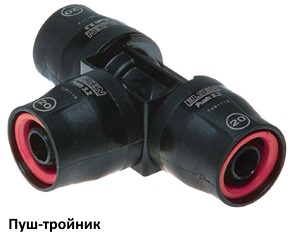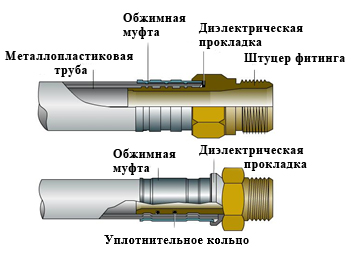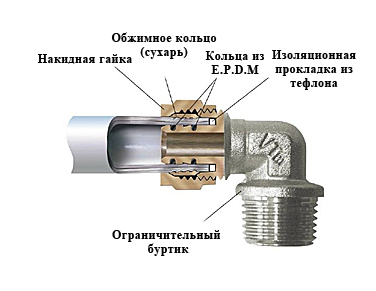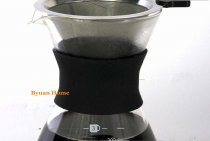Installation of PE-RT and PEX pipes with axial fittings.
The main method of installation of these types of pipes is hidden. That is, pipes are laid inside walls or floors. If we are not talking about water heated floors, then the pipe is laid in a corrugation, which protects it from mechanical and other damage. As for, a separate article was written about them, which I recommend reading. And in order not to be unfounded, I suggest watching a video on the installation of PEX or PE-RT pipes with axial fittings:
I can say that this method of mounting is on the shoulder of any person and there are no special tricks and tricks here. The prices for the instrument, of course, bite, but now it can be easily rented at the box office or from the sellers themselves.
push fittings push fittings

The principle of operation of a push fitting is to self-fix the pipe inserted into it. During installation, the pipe is pressed into the push fitting, putting on an integrated fitting with sealing rings. The system of spring-loaded inner rings presses the pipe firmly against the fitting and does not allow it to leave the fitting. Two EPDM O-rings ensure the required tightness of the connection. The pipe must be calibrated and internally chamfered.
Advantages of push fittings:
-
No special tool required.
Only pipe cutter and calibrator required. -
Ease of installation.
Special skills and "golden hands" are not required. You can independently mount a pipeline from metal-plastic pipes on push fittings. -
Fast installation.
Push fittings allow you to perform a large amount of work in a short time. - Suitable for hard to reach places
-
Can be monolithic.
Push fittings are reliable,
sufficient for concealed installation in building structures (walls, floors).
Disadvantages of push fittings:
-
Borehole narrowing
. This leads to pressure loss in the system due to high local hydraulic resistance in the push fittings. -
High price.
These are the most expensive fittings for metal-plastic pipes.
Summary table for the selection of fittings for metal-plastic pipes
|
Radial press fittings |
Axial press fittings |
Push fittings |
Crimp fittings |
|
|
Possibility of hidden laying |
||||
|
Multiple use |
NOT REALLY |
|||
|
Presence of seal in fittings |
||||
|
Tapering in fittings |
||||
|
Time and ease of installation |
||||
|
Connection reliability |
+++ |
|||
|
System cost |
||||
|
The cost of the tool kit |
Good day to everyone who reads this article. In it, I will briefly talk about axial fittings and pipes for them. They are becoming more and more popular these days. Especially for developers who use them wherever possible and impossible. I try to start all my articles with definitions and there will be no exceptions.
The results of the article.
Talking about the difference and similarity of any products makes sense if in reality they can replace each other when solving the same problem. In new construction, refurbishment and simple refurbishment, you need to decide which fittings to use and why.
Fitting
, they are also called "connecting parts", in addition to the direct connection of pipes to each other, they allow you to simultaneously branch or join different types of pipelines, for example, they make the transition from a polymer pipe to steel or copper. We found that the fitting solves several problems. What qualities should an ideal fitting have?
The ideal fitting should:
Do not obstruct the passage of liquid, i.e. the inner diameter of the fitting should be as close as possible to the diameter of the inner section of the pipe
be 100% sealed
Speed up the process of assembling connections (in other words, be easy to assemble
Do not lose their properties over time, i.e. be durable
Eliminate the possibility of an error during assembly, i.e. easy to mount
Have an affordable price
Most often, when connecting pex pipes and metal-polymer pipes (metal-plastic), special types of fittings are used, but with equal wall thicknesses and outer diameters, fittings originally intended for metal-plastic can be used for assembly. On the contrary, you can't do it.
Let's take a look first XLPE pipe fittings
.
Axial fittings with compression sleeve
- the most common connections for pex pipes. They are very simple and consist of two elements: in fact, a fitting with a fitting (the part of the fitting on which the edge of the pipe is put on) and a fixing sleeve. Both fittings and sleeves can be made of metal (brass sometimes steel) or plastic (polyphenyl sulfone, polyvinyl fluoride, polyethylene). are axial type fittings
and are made from brass. A special tool is required to assemble the axial connection. Due to the fact that the fitting is constructed of homogeneous materials with maximum durability, the connections do not loosen over time, and their service life exceeds 50 years, and thus they are suitable for laying in concrete.
There are two types of fittings for connecting metal-polymer pipes: fittings threaded crimp type
a
and the so-called press fittings
.
The first type of fittings for metal-plastic pipes is called crimp
. It is a combination of a nut with a collet ring and a fitting with a nipple and male thread, which, when tightened, fix the end of the pipe on the nipple. To assemble such a connection, it is enough to have a hex key. There are no other materials other than brass in these joints. However, these fittings are not suitable for laying in floor screed or walls, as threaded connections can loosen over time and should always be left open for inspection and tightening. This type of connection is most often used for finishing apartments and country houses or cottages.
 |
The next type of fittings for metal-plastic is press fitting
. The name comes from the English press - i.e. compression. For such connections, a special tool is always used, which is a round tongs that compress a steel sleeve (removable or fixed) around the fitting fitting, thereby sealing the connection. A feature of such fittings is the use of several materials at once in their design: brass (less often PPSU) for the fitting, stainless steel for the sleeve, EPDM rubber for seals on the fitting and paronite for the dielectric gasket. Due to the heterogeneity of these materials, they lose strength at different rates, which limits the service life of the entire joint to a maximum of 10 years. Such connections do not provide a 50 year service life, which is mandatory when they are placed in concrete structures (floor screed, ceilings or walls). It can be concluded that the use of such connections is justified only when finishing rooms and when laying pipes in temporary decorative partitions (often made of drywall or other panels).
We have considered three types of connections, one for PEX pipes (axial with compression sleeve) and two for metal-polymer pipes (compression and press connection). Only axial fittings have a service life of 50 years providing the reliability required in modern capital construction. Today in Russia, in the construction of apartment buildings with horizontal heating systems, most projects use XLPE pipes with axial fittings.
The results of the article.
TECEflex is a polymer pipe system with a wide range of applications in internal engineering systems.Brass fittings are certified and approved for drinking water, heating, gas and compressed air pipeline networks. The special design of TECEflex multilayer pipes makes them suitable for universal use. The exception is the gas pipe, which has a yellow outer layer. Therefore, TECEflex is truly a versatile piping system.
Universal piping system for all applications in building engineering equipment
- Can be used in pipelines for drinking water, heating and compressed air - "5 systems - one fitting"
- Connection technology without O-rings
- Pipes and fittings with almost the same internal cross-section
- Thick-walled, non-breaking metal-polymer pipes with diameters of 14-63 mm
- Mounting error-tolerant technology
- simple tools
- Wide range of brass fittings with diameters 14-63 mm
- PPSU (polyphenylsulphone) fittings in 16 and 20 mm diameters as an inexpensive alternative
- Error tolerant and reliable
- High temperature resistance and compressive strength
Documents for download:
TECEflex pipes are permanently connected to fittings by axial pressing. Only the pipe material is used as a sealant. No other means such as O-rings or sealing tape are required. The connection technology without O-rings is extremely error-resistant and particularly hygienic.
TECEflex offers a wide range of brass fittings. Universal brass fittings are used for pipeline networks of drinking water, heating, gas supply and compressed air. The fittings are made of special corrosion resistant brass (with low dezincification) recognized in Europe and recommended by the DVGW. In accordance with the current drinking water directives, it is suitable for all water qualities.
The DVGW approval confirms the hygienic and biological suitability of TECEflex for drinking water pipelines and a long service life of at least 50 years. Another strong point is the axial insertion technology without O-rings.
There are no cavities in the joints, and water stagnation, which is important from a hygienic point of view, does not occur anywhere. Fitting materials approved throughout Europe
Thanks to the use of corrosion resistant (CR) brass, TECEflex fittings do not need additional protective layers with complex application technology. The TECEflex system is suitable for all drinking water qualities.
The TECEflex multilayer pipe is equally suitable for drinking water, heating, surface heating and compressed air pipelines. The gas supply pipe differs only in its yellow color. Due to the special design, the universal pipe has a high margin of safety, maintains a round section when bent and does not form burrs when cut. The inner pipe in contact with the medium is made of DVGW-registered polyethylene PE-Xc.
Up to and including a diameter of 32 mm, TECEflex connections can be made with hand tools. Most connections are performed using only muscular strength. No electricity or batteries needed. The tools are very light and extremely reliable. They do not need regular maintenance. To connect the pipes, you just need to push the press sleeve onto the part of the pipe covering the fitting - you get a tight connection!
The piping system can be assembled using various types of connection fittings. The choice of one or another solution is not always obvious, because each type of fitting has its own advantages and disadvantages.



